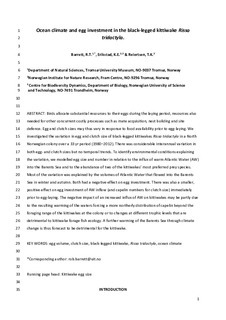| dc.contributor.author | Barrett, Robert T | |
| dc.contributor.author | Erikstad, Kjell E | |
| dc.contributor.author | Reiertsen, Tone | |
| dc.date.accessioned | 2017-10-02T11:06:49Z | |
| dc.date.available | 2017-10-02T11:06:49Z | |
| dc.date.created | 2017-09-13T14:19:22Z | |
| dc.date.issued | 2017 | |
| dc.identifier.citation | Marine Ecology Progress Series. 2017, 579 129-137. | nb_NO |
| dc.identifier.issn | 0171-8630 | |
| dc.identifier.uri | http://hdl.handle.net/11250/2457697 | |
| dc.description.abstract | Birds allocate substantial resources to their eggs during the laying period, resources also needed for other concurrent costly processes such as mate acquisition, nest building and site defence. Egg and clutch sizes may thus vary in response to food availability prior to egg laying. We investigated the variation in egg and clutch size of black-legged kittiwakes Rissa tridactyla in a North Norwegian colony over a 33 yr period (1980–2012). Considerable interannual variation was evident in both egg and clutch sizes, but no temporal trends were observed. To identify environmental conditions explaining the variation, we modelled egg size and number in relation to the influx of warm Atlantic Water (AW) into the Barents Sea and to the abundance of 2 of the kittiwakes’ most preferred prey species. Most of the variation was explained by the volumes of AW that flowed into the Barents Sea in winter and autumn. Both had a negative effect on egg investment. There was also a smaller, positive effect on egg investment of AW inflow (and capelin numbers for clutch size) immediately prior to egg laying. The negative impact of an increased influx of AW on kittiwakes may be partly due to the resulting warming of the waters, forcing a more northerly distribution of capelin beyond the foraging range of the kittiwakes at the colony or to changes at different trophic levels that are detrimental to kittiwake forage fish ecology. A further warming of the Barents Sea through climate change is thus forecast to be detrimental for kittiwakes. Egg volume · Clutch size · Black-legged kittiwake · Rissa tridactyla · Ocean climate | nb_NO |
| dc.language.iso | eng | nb_NO |
| dc.publisher | Inter Research | nb_NO |
| dc.title | Ocean climate and egg investment in the black-legged kittiwake Rissa tridactyla. | nb_NO |
| dc.type | Journal article | nb_NO |
| dc.type | Peer reviewed | nb_NO |
| dc.description.version | acceptedVersion | nb_NO |
| dc.subject.nsi | VDP::Zoologiske og botaniske fag: 480 | nb_NO |
| dc.subject.nsi | VDP::Zoology and botany: 480 | nb_NO |
| dc.source.pagenumber | 129-137 | nb_NO |
| dc.source.volume | 579 | nb_NO |
| dc.source.journal | Marine Ecology Progress Series | nb_NO |
| dc.identifier.doi | 10.3354/meps12270 | |
| dc.identifier.cristin | 1493377 | |
| dc.relation.project | Andre: Norwegian SEAPOP programme | nb_NO |
| dc.relation.project | Andre: Miljødirektoratet | nb_NO |
| dc.relation.project | Norges forskningsråd: 216547 | nb_NO |
| dc.relation.project | Egen institusjon: Universitetet i Tromsø | nb_NO |
| dc.description.localcode | This is the authors' accepted and refereed manuscript to the article. Locked until 14 September 2018 due to copyright restrictions. | nb_NO |
| cristin.unitcode | 194,66,10,0 | |
| cristin.unitname | Institutt for biologi | |
| cristin.ispublished | true | |
| cristin.fulltext | postprint | |
| cristin.qualitycode | 2 | |
